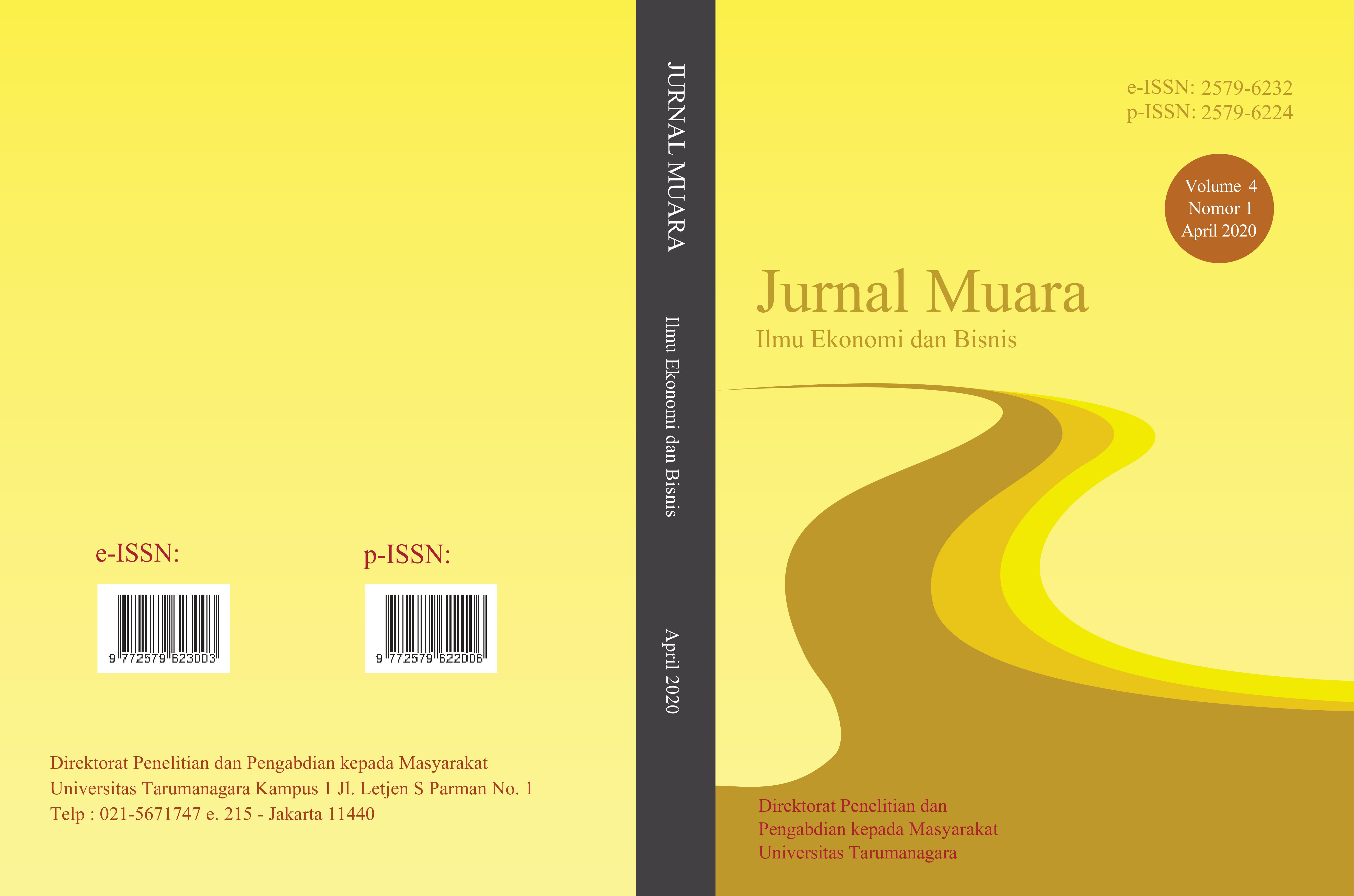PERAN INNOVATIVENESS SEBAGAI MODERASI PADA KETERKAITAN PENGARUH SOSIAL TERHADAP MINAT PEMBELIAN KOPI STARBUCKS
Main Article Content
Abstract
Tujuan penelitian ini adalah untuk mengetahui apakah keinovatifan dapat memoderasi peran pengaruh sosial terhadap minat pembelian kopi Starbucks sebagai produk hijau. Penelitian ini menggunakan metode survey. Responden adalah 100 konsumen Starbucks. Teknik pengambilan sampel adalah convenience sampling. Teknik pengumpulan data menggunakan kuesioner. Teknik analisis data menggunakan Partial Least Square-Structural Equation Modeling. Hasil penelitian menunjukkan bahwa pengaruh sosial berpengaruh terhadap niat membeli kopi Starbucks dan keinovatifan konsumen tidak memoderasi peran pengaruh sosial terhadap minat pembelian kopi Starbuck sebagai produk hijau.
The purpose of this study was to determine whether innovativeness can moderate the role of social influence in the purchase intention of Starbucks coffee as a green product. Respondents were 100 Starbucks consumers. The sampling technique is convenience sampling. Data collection techniques using a questionnaire by survey method. Data analysis techniques using Partial Least Square-Structural Equation Modeling. The results showed that social influence had effect on Starbucks coffee purchase intentions and consumer innovativeness did not moderate the role of social influence on the purchase intention of Starbuck coffee as a green product. This might be due to brand equity factors, collectivistic culture and limited sample size, which can be suggested for future researchers.
Article Details
References
Ajzen, I. (1985). From intentions to actions: A theory of planned behavior. In Action control. 11-39. Springer, Berlin, Heidelberg.
Bartels, J., & Hoogendam, K. (2011). The role of social identity and attitudes toward sustainability brands in buying behaviors for organic products. Journal of Brand Management, 18(9), 697-708. https://doi.org/10.1057/bm.2011.3
Bartels, J., & Onwezen, M. C. (2014). Consumers' willingness to buy products with environmental and ethical claims: the roles of social representations and social identity. International Journal of Consumer Studies, 38(1), 82-89.
Bertrandias, L., & Elgaaied-Gambier, L. (2014). Others’ environmental concern as a social determinant of green buying. Journal of Consumer Marketing.
Chau, P. Y., & Hui, K. L. (1998). Identifying early adopters of new IT products: A case of Windows 95. Information & management, 33(5), 225-230.
Chen, T. B., & Chai, L. T. (2010). Attitude towards the environment and green products: Consumers’ perspective. Management Science and Engineering, 4(2), 27-39. http://dx.doi.org/10.3968/j.mse.1913035X20100402.002
Delre, S. A., Jager, W., Bijmolt, T. H., & Janssen, M. A. (2010). Will it spread or not? The effects of social influences and network topology on innovation diffusion. Journal of Product Innovation Management, 27(2), 267 - 282. Diakses dari
https://doi.org/10.1111/j.1540-5885.2010.00714.x
Environment. (n.d.). Retrieved from http://www.starbucks.co.id/responsibility/environment
Feaster, J. G. (1968). Measurement and determinants of innovativeness among primitive agriculturists. Rural Sociology, 33(3), 339-348.
Fishbein, M., & Ajzen, I. (1975). Belief, attitude, intention and behavior: An introduction to theory and research. Reading, MA: Addison-Wesley Publishing.
Gil, J. M., Gracia, A., & Sanchez, M. (2000). Market segmentation and willingness to pay for organic products in Spain. The International Food and Agribusiness Management
Review, 3(2), 207-226. https://doi.org/10.1016/S1096-
(01)00040-4
Gur?u, C., & Ranchhod, A. (2005). International green marketing: A comparative study of British and Romanian firms. International marketing review, 22(5), 547-561. Diakses dari https://doi.org/10.2307/1252160
Hult, G. T. M., Hurley, R. F., & Knight, G. A. (2004). Innovativeness: Its antecedents and impact on business performance. Industrial marketing management, 33(5), 429-438.
Kemenperin (n.d.). Pasar global produk ramah lingkungan. Retrieved from http://www.kemenperin.go.id/artikel/8810/PasarGlobal-Produk-RamahLingkungan
Klink, R. R., & Athaide, G. A. (2010). Consumer innovativeness and the use of new versus extended brand names for new products. Journal of Product Innovation Management, 27(1), 23-32.
KPMG. (2017). The road ahead: The KPMG survey of corporate responsibility reporting 2017. Diakses dari https://assets.kpmg.com/content/dam/kpmg/xx/pdf/2017/10/kpmg-survey-of-corporate-responsibility-reporting-2017.pdf
Langner, S., Hennigs, N., & Wiedmann, K. P. (2013). Social persuasion: targeting social identities through social influencers. Journal of Consumer Marketing, 30(1), 31-49. https://doi.org/10.1108/07363761311290821
Lee, K. H. (2009). Why and how to adopt green management into business organizations? The case study of Korean SMEs in manufacturing industry. Management Decision, 47(7), 1101-1121. Diakses dari https://doi.org/10.1108/00251740910978322
Lee, M. K., Shi, N., Cheung, C. M., Lim, K. H., & Sia, C. L. (2011). Consumer's decision to shop online: The moderating role of positive informational social influence. Information & Management, 48(6), 185-191. https://doi.org/10.1016/j.im.2010.08.005
Ling, C. Y. (2013). Consumers’ purchase intention of green products: an investigation of the drivers and moderating variable. Elixir Marketing Management, 1, 14503-14509.
Madahi, A., & Sukati, I. (2012). The effect of external factors on purchase intention amongst young generation in Malaysia. International Business Research, 5(8), 153-159. http://www.academia.edu/download/46216485/540660130cf2c48563b24ef2.pdf
Number of Starbucks stores worldwide 2017. (n.d.). Retrieved from https://www.statista.com/statistics/266465/number-of-starbucks-storesworldwide/#0
Park, K., & Lee, K. (2016). Is green product purchasing an innovative or conspicuous behavior? Social Behavior and Personality: An International Journal, 44(1), 29-44. https://doi.org/10.2224/sbp.2016.44.1.29
Persaud, A., & Schillo, S. R. (2017). Purchasing organic products: role of social context and consumer innovativeness. Marketing Intelligence & Planning, 35(1), 130-146. https://doi.org/10.1108/MIP-01-2016-0011
Riek, L. D., & Robinson, P. (2011). Challenges and opportunities in building socially intelligent machines [social sciences]. IEEE Signal Processing Magazine, 28(3), 146-149. Diakses dari http://citeseerx.ist.psu.edu/viewdoc/download?doi=10.1.1.228.8628&rep=rep1&type=pdf
Roehrich, G. (2004). Consumer innovativeness: Concepts and measurements. Journal of business research, 57(6), 671-677. https://doi.org/10.1016/S0148-2963(02)00311-9
Schiffman, L. K., & Kanuk, L. L. (2009). LL (2003): Consumer Behavior. International Edition.
Sheth, J. N. (2009). Wiley international encyclopedia of marketing. N. K. Malhotra (Ed.). Wiley-Blackwell.
Spears, N., & Singh, S. N. (2004). Measuring attitude toward the brand and purchase intentions. Journal of Current Issues & Research in Advertising, 26(2), 53–66. Diakses dari https://doi.org/10.1080/10641734.2004.10505164
Tellis, G. J., Yin, E., & Bell, S. (2009). Global consumer innovativeness: Cross-country differences and demographic commonalities. Journal of International Marketing, 17(2), 1-22.
Turner, J. C., Oakes, P. J., Haslam, S. A., & McGarty, C. (1994). Self and collective: Cognition and social context. Personality and social psychology bulletin, 20(5), 454-463. Diakses dari https://doi.org/10.1177%2F0146167294205002
Wang, T. (2017). Social Identity dimensions and consumer behavior in social media. Asia Pacific Management Review, 22(1), 45-51. https://doi.org/10.1016/j.apmrv.2016.10.003
Wang, Y. H., & Tsai, C. F. (2014). The relationship between brand image and purchase intention: Evidence from award winning mutual funds. The International Journal of Business and Finance Research, 8(2), 27-40. https://ssrn.com/abstract=2322833
WWF. (2017, September 18). Tren konsumsi dan produksi Indonesia: Produsen Mampu sediakan produk ekolabel dan pasar siap membeli. Retrieved from https://www.wwf.or.id/?60462/Tren-Konsumsi-dan-Produksi-IndonesiaProdusen-Mampu-Sediakan-Produk-Ekolabel-dan-Pasar-Siap-Membeli



